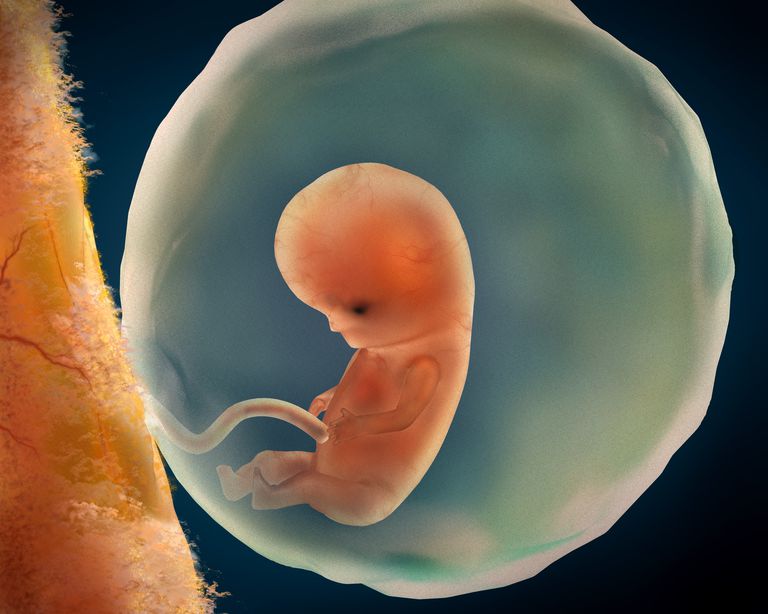After a home pregnancy test has turned positive and a blood test measuring levels of human chorionic gonadotropin (HCG) have confirmed pregnancy, the next proof of pregnancy is an ultrasound. When you have your first ultrasound your doctor may talk about the presence or absence of the gestational sac. What exactly is the gestational sac, when can it first be detected on ultrasound, and what does it mean if it is or isn’t there? What does it mean if a gestational sac is seen, but appears to be empty?
What Is the Gestational Sac?
One of the first signs of pregnancy to show up on ultrasound is the gestational sac, the sac which encloses the developing baby and contains amniotic fluid. The gestational sac is found in the uterus and on an ultrasound, it appears as a white rim around a clear center.
The gestational sac forms around five to seven weeks after the last menstrual period in natural cycles, so it is usually visible between 3 and 5 weeks gestational age using a transvaginal ultrasound.
Transvaginal ultrasound has a higher sensitivity and produces clearer images than a transabdominal ultrasound. The gestational sac is usually seen when your hCG levels are between 1500 and 2000
When a Gestational Sac Is Seen on the Ultrasound?
If a gestational sac is seen on your ultrasound, is this a guarantee of a normal pregnancy? Visualizing a gestational sac is certainly a positive sign of pregnancy, but it is not a guarantee that your pregnancy is healthy and will proceed normally.
For example, after the sac becomes visible, the next positive sign of pregnancy is a yolk sac that develops within it.The yolk sac provides nutrition to the developing embryo until the placenta takes over, and is thus an important indicator of pregnancy health. In some cases, a gestational sac will be detected on ultrasound, but a yolk sac is subsequently not found. The yolk sac usually becomes visible on a transvaginal ultrasound between 5 and 6 weeks gestation

What If a Gestational Sac Is Not Seen?
If a gestational sac is not seen on your ultrasound, what does that mean? There are several possible reasons for a lack of a gestational sac. It could be that:
Your dates are off. This is a common reason and may simply mean that you need a repeat ultrasound later on. It can be helpful to compare this finding with your hCG levels, which would likely be lower than 1500 if you are not as far along as you thought in your pregnancy.2
You have miscarried. It could be that you had a very early miscarriage (chemical pregnancy) or that you will be miscarrying. Falling hCG levels are also a sign of miscarriage.
You have an ectopic pregnancy. If your hCG levels are between 1500 and 2000 but a gestational sac is not seen, it could mean that you have an ectopic pregnancy.
An ectopic pregnancy can be a medical emergency, and if this is a possibility your doctor will want to do further testing and talk about treatment options.

What Does an Empty Gestational Sac Mean?
An embryo is usually seen within the gestational sac by 6 weeks gestation. One of the more common types of miscarriages, known as an anembryonic pregnancy, empty sac, or blighted ovum, happens when a gestational sac does not contain an embryo. In other words, an embryo failed to develop. This type of pregnancy loss occurs early in the first trimester, and often before a woman even realizes she was pregnant. It can be the result of abnormal cell division, poor quality sperm, or a poor quality egg.
In most cases, chromosomal abnormalities will cause the woman’s body to miscarry naturally and without intervention. However, there are some cases in which a woman may choose a dilation and curettage (D&C) to complete the miscarriage. This procedure may be desirable for women who want a pathologist to try to find a cause for the miscarriage, for those who feel it will help them cope better with the loss, or for physical or medical concerns raised by her physician.
What If My Doctor Sees an Empty Gestational Sac?
If your doctor discovers an empty gestational sac on an ultrasound, he may confirm that your pregnancy is nonviable—in other words, that the pregnancy will not result in the birth of a baby as it is not progressing normally.
But sometimes (depending on the size of the gestational sac), it may be a bit too early to determine that the sac is truly “empty.” In this instance, your doctor will ask you to return for a repeat ultrasound. This can be an anxiety-ridden time but is meant to ensure a 100 percent accurate diagnosis (that the pregnancy is either viable or nonviable).
A Word From our Doctor.
Early transvaginal ultrasounds are a relatively easy way to follow a pregnancy early on, and along with hCG levels can give you and your doctor an idea about how your pregnancy is progressing. The gestational sac is the first structure physicians look for with early ultrasound. When it is present (between 3 and 5 weeks gestation), it can be a positive sign. That said, sometimes a gestational sac is seen but is found to be empty, without evidence of an embryo by 6 weeks gestation.
On the other hand, sometimes a gestational sac is not seen. The most common reason for this is inaccurate dates and it is simply too soon. But if a gestational sac is not seen on follow-up, or if your hCG levels indicate one should be seen, you could potentially be having a miscarriage or ectopic pregnancy.
Pregnancy can be a joyful time, but one ridden with anxiety as well when things don’t go as you’d like. Lean on your friends and family members. If it’s thought that you are having a miscarriage, have a blighted ovum, or an ectopic pregnancy, it can be a huge emotional blow. This is especially true as many couples haven’t yet shared their pregnancy with family and friends, so you may feel very alone.
There are stages of grief associated with miscarriage, even when it occurs early. Added to that are the often well-meant but hurtful comments such as “you can always have another.” It’s important to honor your feelings and grieve in the way that’s best for you.
Symptoms of a miscarriage.
The main sign of a miscarriage is vaginal bleeding, which may be followed by cramping and pain in your lower abdomen. If you have vaginal bleeding, contact a GP or your midwife. Most GPs can refer you to an early pregnancy unit at your local hospital straight away if necessary. You may be referred to a maternity ward if your pregnancy is at a later stage. But bear in mind that light vaginal bleeding is relatively common during the first trimester (first 3 months) of pregnancy and does not necessarily mean you’re having a miscarriage
What causes a miscarriage?
There are probably many reasons why a miscarriage may happen, although the cause is not usually identified. The majority are not caused by anything the mother has done. It’s thought most miscarriages are caused by abnormal chromosomes in the baby. Chromosomes are genetic “building blocks” that guide the development of a baby. If a baby has too many or not enough chromosomes, it will not develop properly. For most women, a miscarriage is a one-off event and they go on to have a successful pregnancy in the future
Can miscarriages be prevented?
The majority of miscarriages cannot be prevented. But there are some things you can do to reduce the risk of a miscarriage. Avoid smoking, drinking alcohol and using drugs while pregnant. Being a healthy weight before getting pregnant, eating a healthy diet and reducing your risk of infection can also help.

What happens if you think you're having a miscarriage?
If you have the symptoms of a miscarriage, you’ll usually be referred to a hospital e.g Mristopes Kenya for tests.How a 5 week miscarriage looks like
In most cases, it can be determined if you’re having a miscarriage via a simple ultrasound scan. When a miscarriage is confirmed, you’ll need to talk to your doctor or midwife about the options for the management of the end of the pregnancy. Often the pregnancy tissue will pass out naturally in 1 or 2 weeks.
Sometimes medicine to assist the passage of the tissue may be recommended, or you can choose to have minor surgery to remove it if you do not want to wait.
After a miscarriage
A miscarriage can be an emotionally and physically draining experience. You may have feelings of guilt, shock and anger. Advice and support are available at this time from hospital counseling services and charity groups. You can try for another baby as soon as your symptoms have settled and you’re emotionally and physically ready. Having a miscarriage does not necessarily mean you’ll have another if you get pregnant again. Most women are able to have a healthy pregnancy after a miscarriage, even in cases of recurrent miscarriages.
How common are miscarriages in Kenya?
Miscarriages are much more common than most people realise. Among women who know they’re pregnant, it’s estimated about 1 in 8 pregnancies will end in miscarriage. Many more miscarriages happen before a woman is even aware, she has become pregnant. Losing 3 or more pregnancies in a row (recurrent miscarriages) is uncommon and only affects around 1 in 100 women. The most common sign of miscarriage is vaginal bleeding. This can vary from light spotting or brownish discharge to heavy bleeding and bright-red blood or clots. The bleeding may come and go over several days. However, light vaginal bleeding is relatively common during the first trimester (first 3 months) of pregnancy and does not necessarily mean you’re having a miscarriage. If you have vaginal bleeding, contact your GP or maternity team as soon as possible. If you’ve had 3 or more miscarriages in a row (recurrent miscarriage) and are worried about your current pregnancy, you can go straight to an early pregnancy unit for an assessment.
Other symptoms of a miscarriage include:
- Cramping and pain in your lower tummy
- A discharge of fluid from your vagina
- A discharge of tissue from your vagina
- No longer experiencing the symptoms of pregnancy, such as feeling sick and breast tenderness
When to seek urgent medical help in Kenya.
On rare occasions, miscarriages happen because the pregnancy develops outside the womb. This is known as an ectopic pregnancy. Ectopic pregnancies are potentially serious as there’s a risk you could experience internal bleeding.
Symptoms of an ectopic pregnancy may include:
- Persistent and severe tummy pain, usually on one side
- Vaginal bleeding or spotting, commonly after the pain has started
- Pain in your shoulder tip
- Diarrhoea and vomiting
- Feeling very faint and lightheaded, and possibly fainting

Symptoms of an ectopic pregnancy usually appear between weeks 5 and 14 of the pregnancy. There are many reasons why a miscarriage may happen, although the cause is often not identified. If a miscarriage happens during the first trimester of pregnancy (the first 3 months), it’s usually caused by problems with the unborn baby (foetus). About 3 in every 4 miscarriages happen during this period.
If a miscarriage happens after the first trimester of pregnancy, it may be the result of things like an underlying health condition in the mother.
These late miscarriages may also be caused by an infection around the baby, which leads to the bag of waters breaking before any pain or bleeding. Sometimes they can be caused by the neck of the womb opening too soon.
Second trimester miscarriages in Kenya.
Long-term health conditions – Several long-term (chronic) health conditions can increase your risk of having a miscarriage in the second trimester, especially if they’re not treated or well controlled.
These include:
- Diabetes (if it's poorly controlled)
- Severe high blood pressure
- Lupus
- Kidney disease
- An overactive thyroid gland
- An underactive thyroid gland
- Antiphospholipid syndrome (APS)
The following infections may also increase your risk:
- Rubella (german measles)
- Cytomegalovirus
- Bacterial vaginosis
- HIV
- Chlamydia
- Gonorrhoea
- Syphilis
- Malaria
- Food poisoning
Food poisoning, caused by eating contaminated food, can also increase the risk of miscarriage. For example: listeriosis – most commonly found in unpasteurised dairy products, such as blue cheese toxoplasmosis – which can be caught by eating raw or undercooked infected meat salmonella – most often caused by eating raw or partly cooked eggs.
Medicines in Kenya.
Medicines that increase your risk include:
Misoprostol – used for conditions such as rheumatoid arthritis
Retinoids – used for eczema and acne
Methotrexate – used for conditions such as rheumatoid arthritis
Non-steroidal anti-inflammatory drugs (NSAIDs) – such as ibuprofen; these are used for pain and inflammation
To be sure a medicine is safe in pregnancy, always check with your doctor, midwife or pharmacist before taking it.
Womb structure
Problems and abnormalities with your womb can also lead to second trimester miscarriages.
Possible problems include:
- Non-cancerous growths in the womb called fibroids
- An abnormally shaped womb
Weakened cervix.
In some cases, the muscles of the cervix (neck of the womb) are weaker than usual. This is known as a weakened cervix or cervical incompetence.
A weakened cervix may be caused by a previous injury to this area, usually after a surgical procedure. The muscle weakness can cause the cervix to open too early during pregnancy, leading to a miscarriage.
Polycystic ovary syndrome (PCOS)
Polycystic ovary syndrome (PCOS) is a condition where the ovaries are larger than normal. It’s caused by hormonal changes in the ovaries.
PCOS is known to be a leading cause of infertility as it can lower the production of eggs. There’s some evidence to suggest it may also be linked to an increased risk of miscarriages in fertile women.
Misconceptions about miscarriage.
An increased risk of miscarriage is not linked to:
A mother’s emotional state during pregnancy, such as being stressed or depressed having a shock or fright during pregnancy exercise during pregnancy – but discuss with your GP or midwife what type and amount of exercise is suitable for you during pregnancy lifting or straining during pregnancy working during pregnancy – or work that involves sitting or standing for long periods having sex during pregnancy travelling by air eating spicy food
Recurrent miscarriages.
Many women who have a miscarriage worry they’ll have another if they get pregnant again. But most miscarriages are a one-off event.
About 1 in 100 women experience recurrent miscarriages (3 or more in a row) and many of these women go on to have a successful pregnancy. If you’ve had 3 or more miscarriages in a row (recurrent miscarriages), further tests are often used to check for any underlying cause. However, no cause is found in about half of cases.
These further tests are outlined below.
If you become pregnant, most units offer an early ultrasound scan and follow-up in the early stages to reassure and support parents.
If there’s no pregnancy tissue left in your womb, no treatment is required.
However, if there’s still some pregnancy tissue in your womb, your options are:
- Expectant management – wait for the tissue to pass out of your womb naturally.
- Medical management – take medicine that causes the tissue to pass out of your womb.
- Surgical management – have the tissue surgically removed.
The risk of complications is very small for all these options. It’s important to discuss them all with the doctor in charge of your care.
Expectant management in Kenya.
If you have a miscarriage in your first trimester, you may choose to wait 7 to 14 days after a miscarriage for the tissue to pass out naturally. This is called expectant management.
If the pain and bleeding have lessened or stopped completely during this time, this usually means the miscarriage has finished. You should be advised to take a home pregnancy test after 3 weeks.
If the test shows you’re still pregnant, you may need to have further tests.
If the pain and bleeding have not started within 7 to 14 days or are continuing or getting worse, this could mean the miscarriage has not begun or has not finished. In this case, you should be offered another scan.
After this scan, you may decide to either continue waiting for the miscarriage to occur naturally, or have drug treatment or surgery. If you choose to continue to wait, your healthcare professional should check your condition again up to 14 days later.
Contact your hospital immediately if the bleeding becomes particularly heavy, you develop a high temperature (fever) or you experience severe pain.
After a miscarriage.
A miscarriage can be very upsetting, and you and your partner may need counselling or support. You may also have questions about trying for another baby and what happens to the miscarried foetus.
A miscarriage can have a profound emotional impact, not only on the woman herself, but also on her partner, friends and family.
Advice and support are available during this difficult time.
Remembrance
It’s usually possible to arrange a memorial and burial service if you want one. In some hospitals or clinics, it may be possible to arrange a burial within the grounds.
You can also arrange to have a burial at home, although you may need to consult your local authority before doing so.
Cremation is an alternative to burial and can be performed at either the hospital or a local crematorium. However, not all crematoriums provide this service and there will not be any ashes for you to scatter afterwards.
You do not need to formally register a miscarriage. However, some hospitals can provide a certificate to mark what has happened if you want one
Emotional impact.
Sometimes the emotional impact is felt immediately after the miscarriage, whereas in other cases it can take several weeks. Many people affected by a miscarriage go through a bereavement period.
It’s common to feel tired, lose your appetite and have difficulty sleeping after a miscarriage. You may also feel a sense of guilt, shock, sadness and anger – sometimes at a partner, or at friends or family members who have had successful pregnancies.
Different people grieve in different ways. Some people find it comforting to talk about their feelings, while others find the subject too painful to discuss.
Some women come to terms with their grief after a few weeks of having a miscarriage and start planning for their next pregnancy. For other women, the thought of planning another pregnancy is too traumatic, at least in the short term.
The father of the baby may also be affected by the loss. Men sometimes find it harder to express their feelings, particularly if they feel their main role is to support the mother and not the other way round. It may help to make sure you openly discuss how both of you are feeling.
Miscarriage can also cause feelings of anxiety or depression, and can lead to relationship problems.
Getting support.
If you’re worried that you or your partner are having problems coping with grief, you may need further treatment and counselling. There are support groups that can provide or arrange counselling for people who have been affected by miscarriage.In Kenya there are so many women groups offering this women self support programmes
Read more about dealing with loss and counselling, and find bereavement support services in your area.Organizations like Aunty Jane ,Safe A bortion Kenya.Mariestopes Kenya and now Women for Women Kenya .

